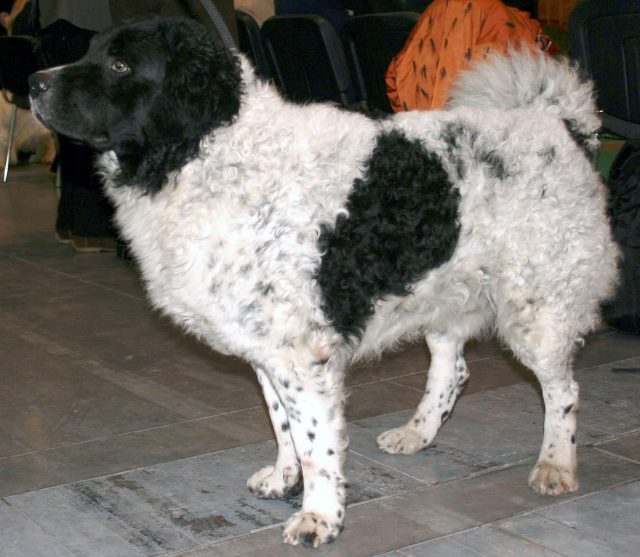Type the name of the breed you're looking for below
[wpdreams_ajaxsearchlite] Don't see the breed your're looking for? Click here and let us know!
Breed Characteristics
1 paw - breed exhibits the least amount of this characteristic
5 paws - breed exhibits most amount of this characteristic
Frisian Water Dog
| Other Names | Wetterhoun, Otterhoun, Dutch Spaniel |
| Country of Origin | Netherlands |
| Weight | 33 - 44 lbs. (15 - 20 kg) |
| Height (at withers) | 21 - 23 in. (53 - 58 cm) |
| Coat | The coarse, thick, curly hair of the Wetterhoun covers the entire body except the head and legs, which have shorter hair. The coat is oily and must not be woolly, as such fur will not resist water. |
| Colour | Coat colour may be solid black or brown, or black with white, or brown with white, with or without white ticking or roan marks. |
| Litter Size | 3 - 6 puppies |
| Life Span | 12 - 14 years |
| Origin & History | The ancestral type of the Wetterhoun was developed at least 400 years ago in the Dutch province of Fryslan. The origins of the Wetterhoun are conjectured to be from Gypsy dogs, crossed with an indigenous Frisian dog, perhaps the Old Water Dog, a type which is now extinct. Dogs of this type were kept for the difficult and dangerous hunting of fitch (Mustela putorius) and otter (Lutra lutra) in the water. The dogs were also used for retrieving waterfowl and as watch dogs. Although the dogs almost disappeared during World War II, fanciers were able to bring the breed back through careful breeding, and it is gaining in popularity. Databases are maintained by the Nederlandse Vereniging voor Stabij- en Wetterhounen (Club for the Stabij and Wetterhoun) and De Wetterhoun Vereniging Nederland[6] for understanding pedigrees and computing inbreeding coefficients. Internationally the breed is recognised by the Fédération Cynologique Internationale in the Water Dogs section of Group 8. The United Kennel Club recognises the breed in its Gundog Group. The breed is also recognized by a number of minor registries, hunting clubs, and internet-based dog registry businesses and promoted as a rare breed for those seeking an unusual pet. |
| Personality | The Wetterhoun is not a suitable dog for beginners. This rugged and soundly built working water dog is an unsinkable capable, canine. It is an all-weather, all-purpose dog that is a popular canine companion and farmhand in its native Holland. It is physically very demanding of itself and can be sensitive. Intelligent and somewhat independent, often with a mind of its own. It is brave, reliable and very watchful. These dogs learn quickly, but they are independent-minded enough to refuse your commands if you are not assertive in a calm manner at all times toward the dog. A consistent but kind approach is absolutely essential. It is strong-willed and needs a firm pack leader. Do not allow this dog to take over the house. Its guarding instinct is still sharp, so training from an early age is imperative. Depending upon the individual dog, corrective action may be appropriate. For its own people, the Wetterhoun is a good-natured and friendly dog. It is good with children in the family, provided the family displays proper leadership, including the children and the children do not tease or harass the dog. It tends to be wary of strangers. This breed makes a good guard dog. Family and friends will get a hearty welcome. It will accept other dogs and pets with no problem. |
Care Requirements
| Health | Breed health concerns may include epilepsy and hip dysplasia. |
| Grooming | This water dog requires little grooming. Comb and brush occasionally. Check that the ears are clean and infection free. |
| Exercise | The Wetterhoun needs lots of exercise, which includes a daily, long, brisk walk. The ideal situation for this dog is to have a large piece of land that it can run around on freely...and which it will protect vigorously. The Wetterhoun likes to swim. |
| Other Considerations | The Wetterhoun is not recommended for apartment life. This breed will be very distressed in an apartment in a busy urban area because these dogs are not suited to such a life. They are rarely seen outside a country setting. The Wetterhoun can live outdoors in a kennel as long as it gets adequate exercise and contact with its humans. It will do well in cold climates as long as it has adequate shelter. |



